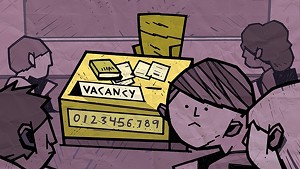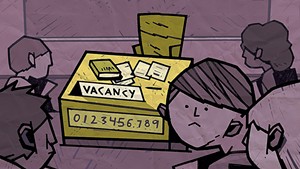
- Thom Glick
Orleans Central Supervisory Union's 1,100 students finished the school year a month ago, but the work hasn't let up for superintendent Penny Chamberlin. That's because she's still trying to fill eight elementary teacher positions and several dozen jobs such as behavioral and academic interventionists, paraeducators, and kitchen staff.
Chamberlin has been meeting with concerned parents, who have taken it upon themselves to brainstorm creative ways to help recruit teachers to the Northeast Kingdom district. Those parents have spent hundreds of dollars of their own money to place job advertisements in newspapers and have posted on job boards of colleges outside of Vermont, in hopes of reaching more applicants.
Preparing for the worst, Chamberlin has also been working with school principals to devise contingency plans in case the district is unable to fill its vacancies. At a school board meeting this week, Chamberlin unveiled a proposal that would combine grade levels within some of her district's six K-8 buildings and have several middle school teachers toggle between two different schools.
"The level of stress and the fact that we're in July ... has me hugely concerned," Chamberlin said in an interview with Seven Days last week.
Orleans Central is not the only district in such a predicament. School leaders across the state say a host of factors — from teacher burnout to a shrinking pipeline of new educators and a dearth of housing — have contributed to an unprecedented shortage of teachers and support staff for the next school year. For many districts, the hiring season — which typically tapers off when school ends — will last all summer.
"Principals and teachers and superintendents take on a lot of stress and a lot of pressure, and we have more and more people who are leaving those fields all the time," Vermont Principals' Association executive director Jay Nichols said. "It's at the crisis point nationally, and Vermont is not immune."
This spring, Orleans Central started conducting exit surveys to assess why staff were leaving. Around 70 percent said they were overworked, burned out or missing time with their family, Chamberlin said.
Chris Hennessey, superintendent of Barre Unified Union School District, said the stress of teaching during the pandemic felt demoralizing and unsustainable to many educators. That, coupled with "younger folks not seeking to enter the profession," has led to the "double whammy" that districts such as his are facing.
Barre currently has vacancies for 20 licensed positions — mostly classroom teachers and special educators — that Hennessey is hustling to fill in the next month and a half. The shortage of special educators is especially problematic, he said, since school districts are required by law to provide services to students with disabilities.
As a new superintendent last year, Hennessey found the hiring process challenging, but "this is much, much more dire," he said. In typical years, most teacher hiring would be done by May, with only a few positions to fill in the summer, he said. That now feels like "a long-ago luxury."
Slate Valley Unified School District superintendent Brooke Olsen-Farrell has also been scrambling. She spent part of her vacation a few weeks ago interviewing candidates remotely. She's looking for 17 paraeducators, alternative ed instructors, a school counselor and a high school science teacher.
Five years ago, Olsen-Farrell said, the district might have gotten 100 applications for an elementary teacher position. Now, it's lucky to get one. So she's had to make concessions. Slate Valley has hired more teachers for positions they don't hold licenses for, which means the district has had to apply to get them two-year provisional licenses or one-year emergency ones through the Vermont Agency of Education. Having less-qualified teachers affects the quality of instruction the district is able to provide, she said.
Like Chamberlin, Olsen-Farrell has already begun mapping out what her district could do if she's unable to staff up. She could ask high school teachers to give up their planning periods to teach an additional course in exchange for more pay; combine two smaller classes into one; or suspend some high school courses for a semester.
Olsen-Farrell and other school leaders said one huge barrier to recruiting new teachers is the lack of affordable housing around the state.
Chamberlin, of Orleans Central, said there are few rental properties in the Northeast Kingdom and houses right now cost around $400,000 to $500,000 — more than a teacher can typically afford. The lack of childcare providers in the region is also a concern.
Sherry Sousa, superintendent of Windsor Central Supervisory Union — which serves Woodstock, Killington, Barnard, Pomfret and Reading — said her district lost out last year on two strong out-of-state teaching candidates because they could not find housing within 45 minutes of school. She realized her job wasn't just hiring skilled teachers but also making sure they had a place to live.
The Woodstock Economic Development Commission connected Sousa with local landlords, and she's been able to help three or four new teachers find homes for the next school year. One landlord was willing to drop the price of rent because he wanted to support teachers, she said.
Other school leaders are also employing new retention and hiring strategies. Last spring, Michael Clark, superintendent of Grand Isle Supervisory Union, offered teachers a $1,000 signing bonus if they returned their contracts by April 25, rather than waiting until the May 15 deadline. The district provided a similar incentive to support staff. This gave Clark a clearer picture of who was coming back and allowed him to get a jump start on hiring for the next school year.
The investment appears to have paid off. Clark said he's in good shape in terms of staffing, with the exception of Alburgh Community Education Center, for which he is still looking to fill five teaching positions. It's early enough in the summer that he thinks he'll be able to do so.
Burlington School District communications specialist Russ Elek said there are between 20 and 25 full- and part-time teacher openings, but administrators feel confident that they'll be "in a good spot" when school reopens. The district is more worried about hiring enough paraeducators and workers in food and property services.
Barre superintendent Hennessey wasn't as optimistic when it comes to hiring teachers. He said he'd like to get more guidance from the Agency of Education about what districts such as his should do.
"We are going to need state-level communication on this. Not in a month — like, now," Hennessey said. "We can't be left hanging on this."
In a statement to Seven Days, the Agency of Education said it's using multiple strategies to help school districts, including working with individual districts on how to fill vacant positions and spending federal COVID-19 relief funds on wellness initiatives in order to make education jobs more appealing. The agency has also commissioned a study, due at the end of the year, to look at how the state might modify licensing regulations in order to address workforce shortages.
This year, the legislature passed Act 173, which allows retired educators to return to the classroom for up to three years without affecting their pension benefits. The Agency of Education does not yet have data on how many retirees have opted to take advantage of the program, but some school leaders don't believe it will make much of a difference. Olsen-Farrell said she's approached retired teachers, but they "have no interest in coming back."
Vermont Superintendents Association executive director Jeffrey Francis, who advocated for Act 173, would like the state to take a more systematic approach to address the teacher shortage.
"Vermont is such a compact state ... but we've got 54 different [school] systems," Francis said. "The problem of disorganization makes it more challenging to address a situation like not having enough teachers to serve the kids."
And it's the kids who will feel the most lasting effects.
Last month, Fiona Bock — a rising seventh grader at Orleans Central's Glover Community School — made that point in a letter, cosigned by eight of her classmates, to superintendent Chamberlin, the school board and her town's selectboard. Fiona laid out strategies she thought would help recruit teachers: higher salaries, financial assistance for housing, more advertising and allowing for teachers' kids to attend the school they work in.
"As students who are unsure of who will be teaching us next year, it is truly rattling, scary and unsettling to know that we do not have any teachers to take the place of those who are leaving," she wrote. "We feel vulnerable to realize that there is nobody set to teach us. We, the youth, demand a good education, and to have a good education, we need good teachers."












Comments
Comments are closed.
From 2014-2020, Seven Days allowed readers to comment on all stories posted on our website. While we've appreciated the suggestions and insights, right now Seven Days is prioritizing our core mission — producing high-quality, responsible local journalism — over moderating online debates between readers.
To criticize, correct or praise our reporting, please send us a letter to the editor or send us a tip. We’ll check it out and report the results.
Online comments may return when we have better tech tools for managing them. Thanks for reading.